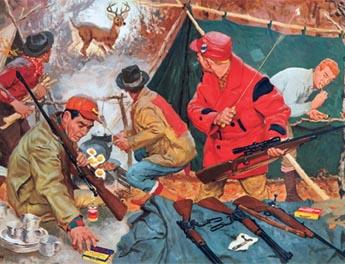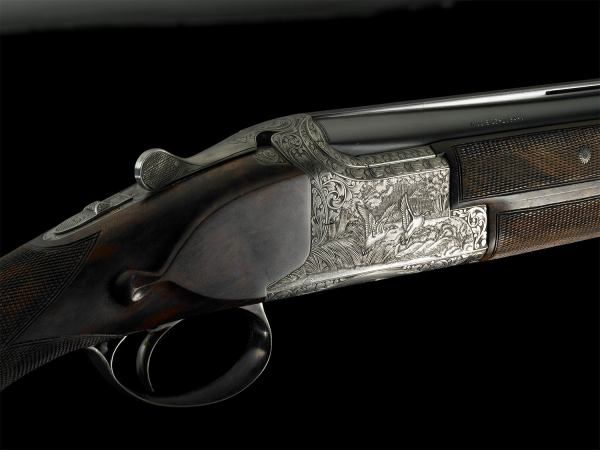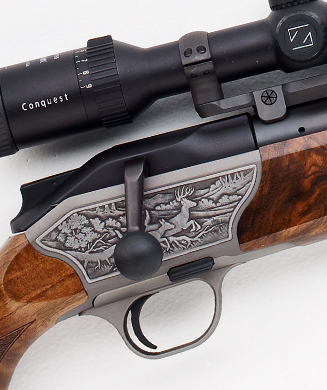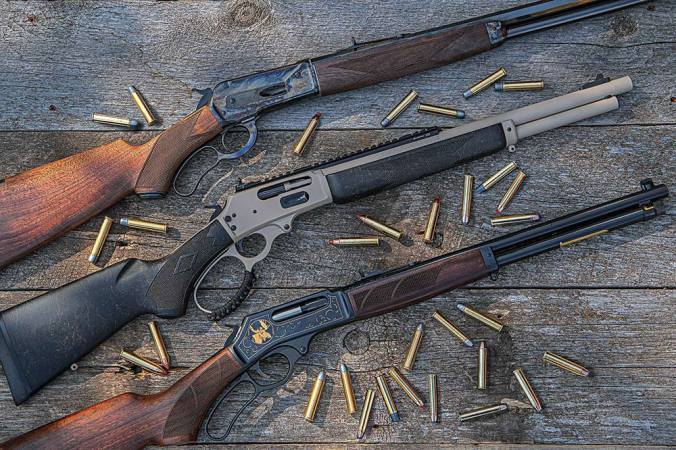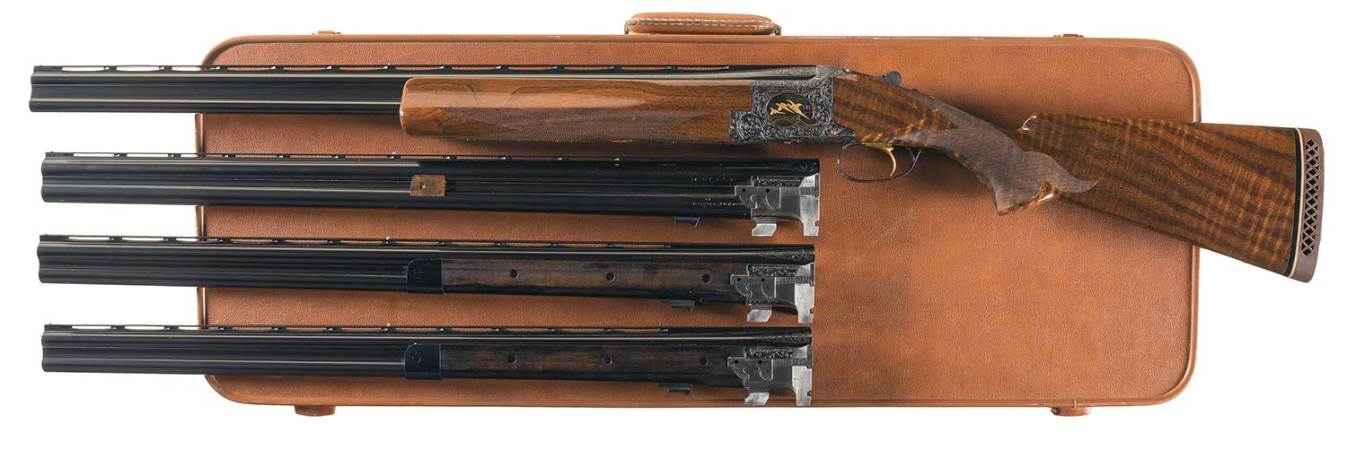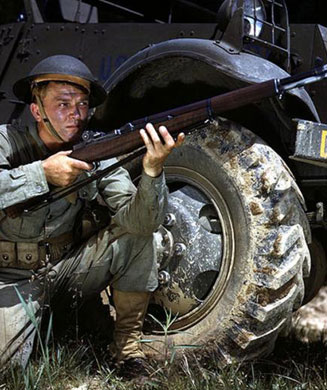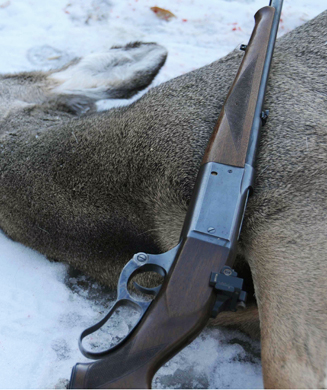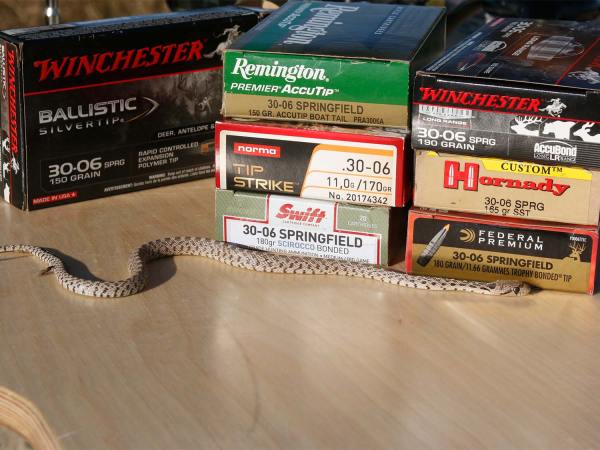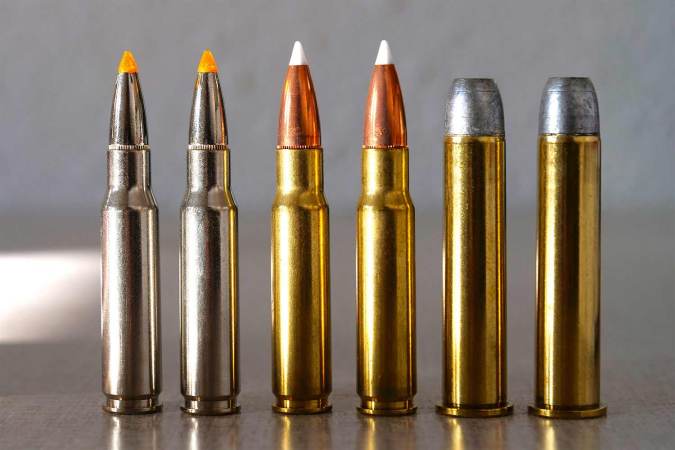We may earn revenue from the products available on this page and participate in affiliate programs. Learn More ›
Name three things that are uniquely American and one of them will probably be the lever-action rifle. For nigh on to a century and a half the lever rifle, along with the revolving-cylinder pistol, has been the uniquely American invention that sets our firearms design, manufacture and usage distinctly apart from the rest of the world’s.
To put the importance of the lever rifle into some perspective, consider that only in the past decade has an American firm produced a double- barreled shotgun comparable to those of the top European makers. And the U.S.-made bolt-action rifles on which modern riflemen dote are, to a great degree, only modifications of European developments. But in no country but the U.S. has the lever rifle been bred, cherished and used so successfully. In fact and legend, from movies such as Stagecoach and Winchester 73 to real-life performances like Buffalo Bill’s Wild West Show, it is the lever-action rifle that wins the day and unfurls the banner saying “Made in America.”
A history of the lever rifle-even of only one of its makers-would fill volumes (for Winchester it already has, many times over). Lever rifles are integral to American history from the Civil War forward, and as with any history so vast, we chart its course only by highlighting what was and what might have been. Perhaps mostly we visualize the lever rifle as the gun that won the West: John Wayne with his hoop-levered Winchester, or Annie Oakley dazzling a crowd of New Yorkers with her Marlin by shooting 25 shots into one jagged hole in 27 seconds at a distance of 36 feet. Or perhaps our favorite image of the lever rifle is a faded photograph of grandly mustachioed hunters in a Maine deer camp, lounging with their rifles before a sagging meat pole. Closer to home, the lever rifle may remind you of the buck you bagged last season, or stir happy memories of seasons past and anticipations of more to come. [pagebreak] The Golden Age
In recent times many hunters and sport shooters have become so fixated on powerful cartridges and long-range accuracy-the domain of bolt rifles-that a class of elitists has emerged that peers down its scope-dented nose at lever rifles, dismissing them as relics from a century long past. To be sure, the lever rifle is a product of the 1800s. Its golden era lasted from 1866 (when the Henry rifle was replaced by Winchester’s legendary Model 1866-the rifle you “loaded on Sunday and shot all week”) to about 1925, give or take a dozen years. During that age, when America emerged as a world power and our engineering and manufacturing know-how raced ahead of other nations’, the lever-rifle concept flowered and failed in ways that are now almost forgotten.
Oliver Winchester, the quintessential American entrepreneur whose lever rifles became an icon, might surprise us if he were resurrected for an interview. As with many other businessmen of his unrestrained generation, his product did not quite follow the course he envisioned. His sights were set on the great fortunes to be had by making muskets-lever-action muskets-for the armies of the world. He summed up such ambitions and his growing frustration in an eloquent appeal: “Where is the military genius,” he lamented, “who is to grasp this whole subject, and so modify the science of war as to best develop the capacities of this terrible engine, the exclusive control of which would enable any government to rule the world?”
Sadly for poor Oliver, the military geniuses he hoped would embrace his “terrible engine” were mainly of a mind that repeating rifles encouraged soldiers to waste ammunition. Still, he managed to eke out a fortune, and several models of Winchester muskets were, in fact, sold to various governments, including that of Czarist Russia, which ordered shipments of the Model 1895. The U.S. Army also ordered a quantity of Model ’95s chambered for what was then called the .30 Government, now knowas the .30/40 Krag.
The Model 1895 is of particular interest for a couple of other reasons, one being that it had a box magazine rather than a tubular design, which allowed the use of pointed bullets. It was a John Browning design with sufficient strength to be chambered for powerful smokeless powder cartridges such as the .30/06 and .405 Winchester, and thus it challenged the advancing popularity of bolt-action rifles in the newer calibers. Upward of half a million ’95s were made between 1896 and the 1930s, during which time no less a hunter than Teddy Roosevelt favored the M-1895 in .405 caliber for African game. Now obsolete, the .405 cartridge, which was designed for the 1895 rifle, had a muzzle velocity of 2,200 feet per second (fps) with a 300-grain bullet, which is only some 300 fps less than the .375 H&H; Magnum. Teddy particularly liked his M-’95 in .405 for lions, and come to think of it, the combination would be about perfect for the purpose even today because it offers twice the shots of a double rifle and operates a lot faster than a bolt gun. I’ve never fired an M-’95 in .405 caliber, and have no plans to do so, since my shoulder is chronically allergic to hard-kicking rifles with sharp-edged steel buttplates. [pagebreak] Winchester’s Best
The phrase “they don’t make ’em the way they used to” is nowhere better applied than to Winchester’s Model 1886. Another John Browning design that remained in production until 1935, the M-1886 had a longer action than earlier Winchesters and employed a locking system that enabled it to be offered in longer, more powerful cartridges such as the .45/70 Government and .50/110 Winchester.
In my opinion, the Model 1886 Winchester represents the highest level of American gun making because it was produced with what were then state-of-the-art machine-tool, mass-production techniques combined with exquisite fitting and finishing in the best traditions of handcraftsmanship. Though we tend to dote on the fine Fox and Parker shotguns of that sublime era, one has only to examine closely the fitting of an 1886 Winchester and feel the oily smoothness of its operation to appreciate fully the magnificence of American gun making-an achievement made all the more remarkable by the fact that these guns were produced by the tens of thousands.
According to The Blue Book of Gun Values, an ordinary and unadorned 1886 Winchester in good condition will sell for upward of $5,000, with rarer versions fetching a lot more than that. The factory- engraved and gold inlaid 1886 rifle shown with this column, which comes from the matchless Bob Lee collection, falls in the priceless category, so don’t even bother to ask.
Speaking of which, a few months ago a lever rifle sold at auction for $683,200! Sure, it was a rare item- a Model 1873 “one of a thousand” in unfired condition-but the sale of such a rifle illustrates how the great lever rifles of Marlin, Winchester and Savage have gone from ordinary workaday tools of American life to treasures of American art. So modern-day rifle elitists who categorize lever rifles as has-beens may find themselves in the rather awkward position of condemning other such has-beens as the art of Frederick Remington and Charlie Russell.
Marlin and Savage
Though Winchester’s lever rifles get the largest share of historical and collector interest, the rifles of Marlin and Savage also earned great measures of respect.
The Marlin lever-action rifle became famous for its graceful lines and foolproof operation. (The solid top of the Marlin receiver is a significant advantage over the open-top Winchester.) And at the time of its introduction, the Model 99 Savage lever rifle was one of the most advanced and reliable sporting firearms designs in the world. So strong was the Model 99 that over its almost century-long production (they’re still talking about reintroducing it at Savage), it easily adapted to modern, high-pressure cartridges.
Looking Ahead
So where does the lever rifle fit into the modern hunting scene? Is it an anachronism from a bygone century or does it have a future?
Two decades ago I wouldn’t have swapped a moth-eaten bearskin rug for its future. Three new cartridges that were supposed to breathe new life into the lever legacy-the .307, .356 and .375 Winchesters-were all DOA. Savage’s ’99 was at death’s door and Winchester’s sleek M-88, Marlin’s Models 57 and 62 Levermatics and Sako’s Finnwolf had already succumbed. (All of them were hammerless models-there’s a lesson there somewhere.)
But true to the American spirit, the darkest days inspired a new beginning, and today lever rifles top the “must have” wish lists of legions of hunters. One big reason is that their makers are closely watching trends in shooting and hunting and are responding to what buyers want rather than trying to dictate the market the way they did in the old days. Browning, for example, now offers a lengthened version of its BLR in .270, .30/06 and even 7mm Rem. Mag. and .300 Win. Mag. And Winchester’s ageless ’94, the biggest-selling lever rifle of all time, has passed the 6 million mark and is still going strong.
At last count some eight different versions were being offered.
Marlin’s slick little M-1894 “Cowboy Competition” rifle charmed the Outdoor Life test team earlier this year, and its big-caliber Guide Series is, well, booming. (See “The Boom in Big Bores,” Shooting, October.) There is always a new beginning for the lever gun and we never cease to be enchanted by its lore and legend. Take a young boy to a gun shop and watch his eyes light up when he picks up a .22-caliber lever rifle.
Lever rifles such as the Marlin 336 and Winchester’s ’94 in everlasting calibers like the .30/30 and .35 Remington have been around so long and have become such an integral part of the hunting scene that we tend to ignore them. But perhaps this is our ultimate compliment, knowing that they are there-always have been and always will be. t at Savage), it easily adapted to modern, high-pressure cartridges.
Looking Ahead
So where does the lever rifle fit into the modern hunting scene? Is it an anachronism from a bygone century or does it have a future?
Two decades ago I wouldn’t have swapped a moth-eaten bearskin rug for its future. Three new cartridges that were supposed to breathe new life into the lever legacy-the .307, .356 and .375 Winchesters-were all DOA. Savage’s ’99 was at death’s door and Winchester’s sleek M-88, Marlin’s Models 57 and 62 Levermatics and Sako’s Finnwolf had already succumbed. (All of them were hammerless models-there’s a lesson there somewhere.)
But true to the American spirit, the darkest days inspired a new beginning, and today lever rifles top the “must have” wish lists of legions of hunters. One big reason is that their makers are closely watching trends in shooting and hunting and are responding to what buyers want rather than trying to dictate the market the way they did in the old days. Browning, for example, now offers a lengthened version of its BLR in .270, .30/06 and even 7mm Rem. Mag. and .300 Win. Mag. And Winchester’s ageless ’94, the biggest-selling lever rifle of all time, has passed the 6 million mark and is still going strong.
At last count some eight different versions were being offered.
Marlin’s slick little M-1894 “Cowboy Competition” rifle charmed the Outdoor Life test team earlier this year, and its big-caliber Guide Series is, well, booming. (See “The Boom in Big Bores,” Shooting, October.) There is always a new beginning for the lever gun and we never cease to be enchanted by its lore and legend. Take a young boy to a gun shop and watch his eyes light up when he picks up a .22-caliber lever rifle.
Lever rifles such as the Marlin 336 and Winchester’s ’94 in everlasting calibers like the .30/30 and .35 Remington have been around so long and have become such an integral part of the hunting scene that we tend to ignore them. But perhaps this is our ultimate compliment, knowing that they are there-always have been and always will be.

